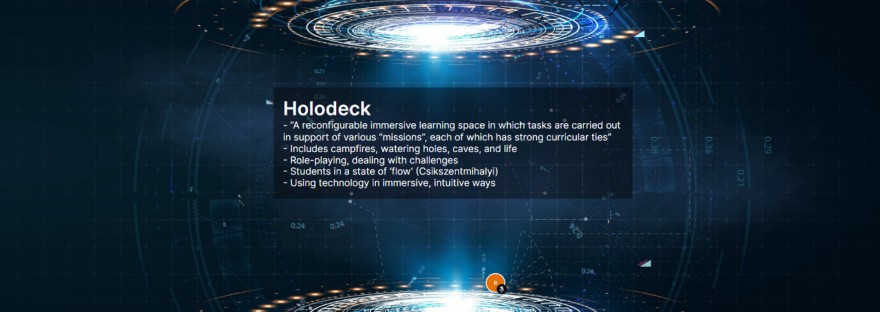Vicki Dale1, Rob Lindsay2, David Watson2 and Tünde Varga-Atkins2
1Academic and Digital Development, University of Glasgow
2Centre for Innovation in Education, University of Liverpool
This year, we facilitated two staff development workshops during events for the Active Learning Network, inspired by Thornburg’s (2013) archetypal learning spaces, having first encountered these in Hewes’ (2013) blog post on this subject. These constitute the ‘campfire’, a place of oration and storytelling; the ‘waterhole’, a location for collaboration and dialogue; the ‘cave’, a quiet area for reflection and introspection, and ‘life’ (a later extension of the taxonomy), which offers opportunity for meaningful application and problem solving. Together with delegates, we explored these spaces within what Thornburg calls the ‘holodeck’, an immersive technical environment that enables learners to engage in compelling ‘missions’ to solve real world challenges.
Screenshots of SpatialChat, showing the archetypal spaces
Our holodeck was facilitated by the use of SpatialChat (www.spatial.chat), a virtual collaboration space that is highly customisable, used at the Centre for Innovation in Education, University of Liverpool, with international collaborators, to deliver ‘Islands of innovation’ academic and digital development events at scale in recent years (e.g. see Reis et al., 2023). The concept of supporting learners on ‘missions’ in the holodeck chimed particularly well with this year’s ‘Intergalactic islands of innovation’ event (Centre for Innovation in Education, 2023).
Engaging with Thornburg’s archetypal learning spaces encouraged us to reflect on the places and spaces that we offer our learners – digitally and in person – to engage most effectively in active learning. Thornburg identified digital equivalents for his spaces; Khan Academy style digital mini-lectures and activity triggers for the campfire, social media and wikis representing the waterhole, games and programming as cave tasks, the use of 3D design tools or programming devices such as Arduino or Raspberry Pi for life application, and haptics or virtual reality for the holodeck. Within SpatialChat, with embedded Padlet boards, we created realistic environments to provide opportunities for individual and collaborative learning.
There is a temptation to think that active learning is always cooperative or collaborative; something that Spaeth and Pearson (2023) encourage us to move away from particularly in terms of supporting neurodiverse learners; “Do not use group work as default” (p. 115). Thus, we need the cave, to ensure that learners to have time to think and reflect individually, to consolidate and make sense of their learning, complemented by participation in those other learning space types such as the waterhole that are more collaborative, but which can be challenging for some students (Pringle Barnes et al., 2023).
Although we embraced Thornburg’s taxonomy as an opportunity to think about how we actively engage learners online and in person, some aspects are worth revisiting since the work was originally published. When Thornburg conceptualised the campfire as a space for storytelling, he was envisioning the lecture hall, typified in the medieval depiction of people sitting in pews falling asleep in front of the orator. With more student-centred models of learning and teaching prevailing, perhaps the campfire may be reconceptualised as a communal space of storytelling and presenting the outcomes of learning – thus, in a way, it becomes more akin to the waterhole. However, it could be useful to retain the element of didactic instruction which is always present, even in the form of signposting and instructions to scaffold and facilitate independent or collaborative learning. Could this didactic element (together with the curriculum) be rethought of as the ‘map’ to facilitate the active learning journey, and the waterhole becomes a more social and equitable campfire? Where does assessment fit into this picture? We could perceive it taking place formatively in all of the archetypal spaces, and summatively across the holodeck, with learning for assessment (Black et al., 2003 cited in Black et al., 2004) and real-world application forming a core part of the student missions.
As we evolve our thinking, we look forward to exploring the holodeck at future events, and further opportunities to explore virtual and physical spaces to optimise student learning. We would love to share ideas around this and invite you to join us on our future missions!
References
Black, P., Harrison, C., Lee, C., Marshall, B., & Wiliam, D. (2004). Working inside the Black Box: Assessment for Learning in the Classroom. Phi Delta Kappan, 86(1), 8-21. https://doi.org/10.1177/003172170408600105
Centre for Innovation in Education. (2023). Intergalactic Islands of Innovation 2023. https://www.liverpool.ac.uk/centre-for-innovation-in-education/conferences/islands-of-innovation/
Hewes, B. (2013, February 20). Metaphors for learning: archetypal learning spaces. Bianca Hewes. https://biancahewes.wordpress.com/2013/02/20/metaphors-for-learning-archetypal-learning-spaces/
Pringle Barnes, G., Levesque, M., & Vecino, A. T. (2023, July 28). Onboarding students to active learning. https://uofgadd.team/2023/07/28/onboarding-students-to-active-learning/
Reis, C., Varga-Atkins, T., & Lindsay, R. (2023, February 8). Islands of Innovation: around the campfires of collaboration. thesedablog. https://thesedablog.wordpress.com/2023/02/08/islands-of-innovation-around-the-campfires-of-collaboration/
Spaeth, E., & Pearson, A. (2023). A reflective analysis on neurodiversity and student wellbeing. Journal of Perspectives in Applied Academic Practice, 11(2), 109-120. https://doi.org/https://doi.org/10.56433/jpaap.v11i2.517
Thornburg, D. (2013). From the campfire to the holodeck: Creating engaging and powerful 21st century learning environments. John Wiley & Sons.






